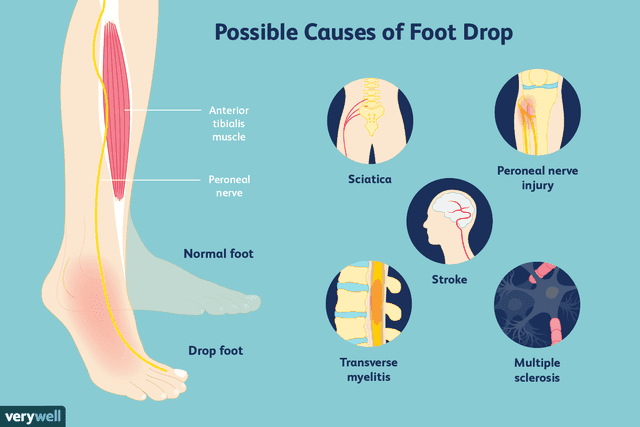How to Treat Foot Drop With an Elastic Resistance Band
Medically reviewed by Laura Campedelli, PT, DPTFact checked by Angela Underwood
If you have suffered an injury or illness that results in foot drop, then you understand how this condition can affect the way you walk. Foot drop can make walking difficult, and it can place increased stress on other parts of your body.
Possible Causes
Foot drop occurs whenever the muscle in the front of your shin, called the anterior tibialis, fails to function properly. This can occur with various types of injuries including, but not limited to:
Sciatica
Stroke
Multiple sclerosis
Peroneal nerve injury
Amyotrophic lateral sclerosis
If your anterior tibialis is not working properly, then when you walk, your foot does not lift up as you are swinging your leg forward. This results in foot drop and a compensatory gait pattern called a high steppage gait.
To clear your foot and toes over the ground while walking, you flex your hip and knee excessively when swinging your leg forward.

Gary Ferster / Verywell
Physical Therapy
Physical therapy for foot drop may help you quickly return to normal walking and mobility. Your physical therapist can use various treatment modalities and exercises to help improve the function of your leg.
The main goal of physical therapy for foot drop is to help your anterior tibialis muscle contract properly. Neuromuscular electrical stimulation may be used. Specific exercises are typically prescribed to improve strength in your anterior tibialis.
Sometimes, the improvement in your muscle function is slow, and occasionally damage to the nerve causing your foot drop is permanent. You may require a brace, called an ankle foot orthosis, to help lift your foot off the ground while walking.
Treatment With a Resistance Band
Another technique your physical therapist may suggest to help lift your toes and foot up while walking with foot drop involves an elastic band. Elastic resistance bands are often used in physical therapy clinics for exercises, but you can also use one to treat foot drop. Here is how you do it:
Obtain an elastic band from your physical therapist. An ACE bandage can also be used.
Sit in a chair with your foot resting comfortably on the floor. Make sure you are wearing shoes.
Wrap the elastic band around the ball of your foot, then bring it back up your leg to wrap around the knee. Next, bring it back up and down again to make sure it is secure, but not too tight that it cuts off your circulation.
When you stand up and attempt to walk, the elastic band will pull up on your foot and toes. This will help clear your foot as you swing your leg forward.
The elastic band can help pull your foot up while walking if you have foot drop, but it is only a temporary solution to be used immediately after your injury while your anterior tibialis muscle is still too weak to lift your foot up.
If your foot drop is a permanent condition, then an ankle foot orthosis is a more appropriate device to use to help accomplish this task.
A Word From Verywell
If you have anterior tibialis weakness that results in foot drop, you may benefit from the skilled services of a physical therapist to help improve your overall function related to walking.
Using an elastic resistance band to help lift your foot while walking can be an effective temporary solution for foot drop. This can allow you to maintain appropriate walking ability until your symptoms resolve completely or until a more permanent solution can be found for your foot drop.
Read the original article on Verywell Health.

